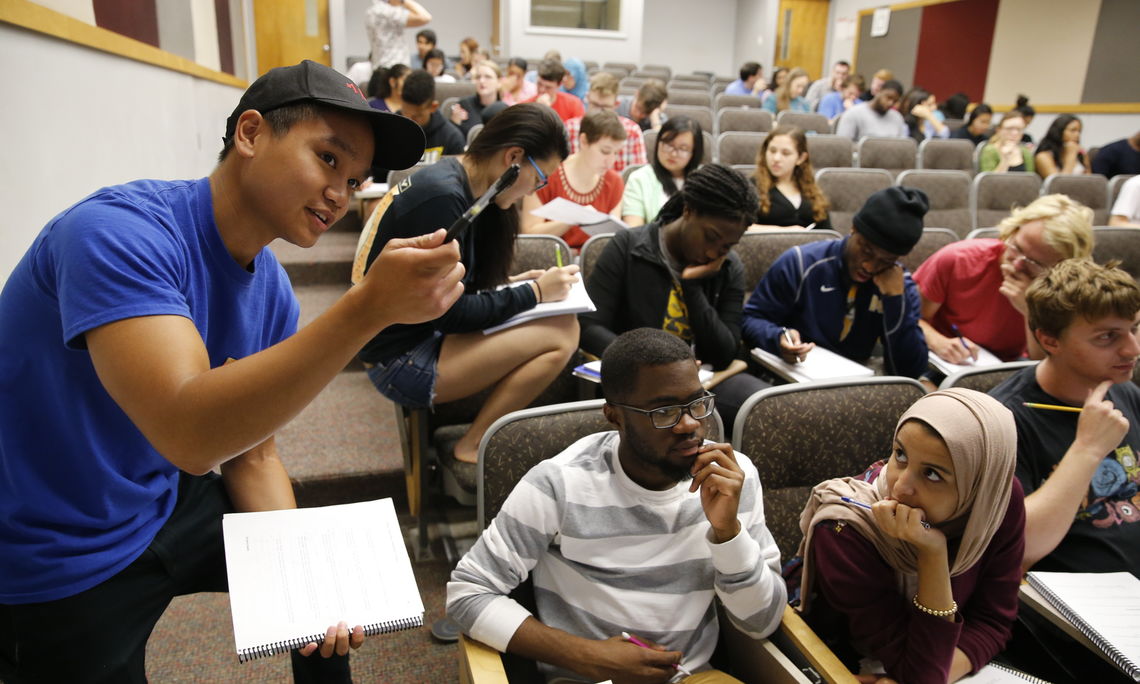Dealing with Large Class Sizes
It's different when you have 100, 200, or 500 students. That means 25 to 100 teams.
All of the facilitation and reporting actions you would take in a classroom of 20 to 40 are logistically challenged here. Nevertheless, experienced POGIL practitioners do not find this an insurmountable barrier. To guide decision-making, it is critical to keep theoretical principles regarding inquiry learning, cooperative structure, and process skills of POGIL in mind. How these principles are enacted will differ from the small classroom situation.

From prior experience, students know what to do when the instructor talks -- they write down what is said. But when the instructor is NOT talking, they may be at a loss. Describing expectations is key, what they are expected to do and how you as instructor will be guiding them and supporting their learning. There is no reason to keep secret the course rationale and design. Sharing the perspective that class will be conversation and not just listening and note-taking can help students become partners who have a stake in the process and outcomes. Secondly, establishing class routines early will simplify logistics and minimize wasted time for pick-up of materials, setting roles, written report expectations, and clicker protocols.
All of the functions that occur in smaller POGIL classrooms can be implemented in larger ones, just in a different way. Teams may be self-assembled rather than fixed to reduce instructor management and allow flexibility because of absences. Three in a team may work better given seating arrangements. Role rotation may be managed by students via incentives to assume each role a minimum number of times. Activity work may be punctuated more frequently by reporting to prevent teams from diverging too much. Reporting mechanisms that include everyone, such as clickers, small white board work sharing, tablet PC screen sharing, and which are visible to all help sustain momentum where oral reports are harder to hear and follow. Written daily reports can sample for evidence of critical ideas rather than be a comprehensive record, which makes for a quick instructor review.
Some instructors go it alone in class. Some have past students as assistant facilitators, who monitor and support a small number of teams, and report to the instructor. The assistants are provided a separate class as preparation. Leaving rows open allows facilitators to traverse classrooms quickly and to get to inaccessible teams. Assessment of team dynamics or process skills may be accomplished by well-designed clicker questions then shared as a point of discussion for the class.
Further details about large class strategies and rationales will be found in an upcoming book.
- S. S. Hunnicutt, S. M. Ruder, E. Yezierski, K. Amaral, C. Bauer. “Large Classes” in POGIL: An Introduction to Process Oriented Guided Inquiry Learning for Those Who Wish to Empower Learners, S. Simonson, Ed., Stylus. In preparation. 2017.
Other citations:
- Ellen J. Yezierski, Christopher F. Bauer, Sally S. Hunnicutt, David M. Hanson, Katie E. Amaral, and James P. Schneider, “POGIL implementation in large classes”, Chapter 6 in “Process-Oriented Guided Inquiry Learning (POGIL)”, R. Moog, J. Spencer, Eds.; ACS Symposium Series, American Chemical Society: Washington, 2008.
- Bailey, CP; Minderhout, V; Loertscher, J. , Learning transferable skills in large lecture halls: Implementing a POGIL approach in biochemistry. BIOCHEMISTRY AND MOLECULAR BIOLOGY EDUCATION; JAN-FEB, 2012; 40; 1; p1-p7
- Trevathan, Jarrod; Myers, Trina; Gray, Heather . Scaling-Up Process-Oriented Guided Inquiry Learning Techniques for Teaching Large Information Systems Courses. Journal of Learning Design , 2014, Vol. 7 Issue 3, p23-38.